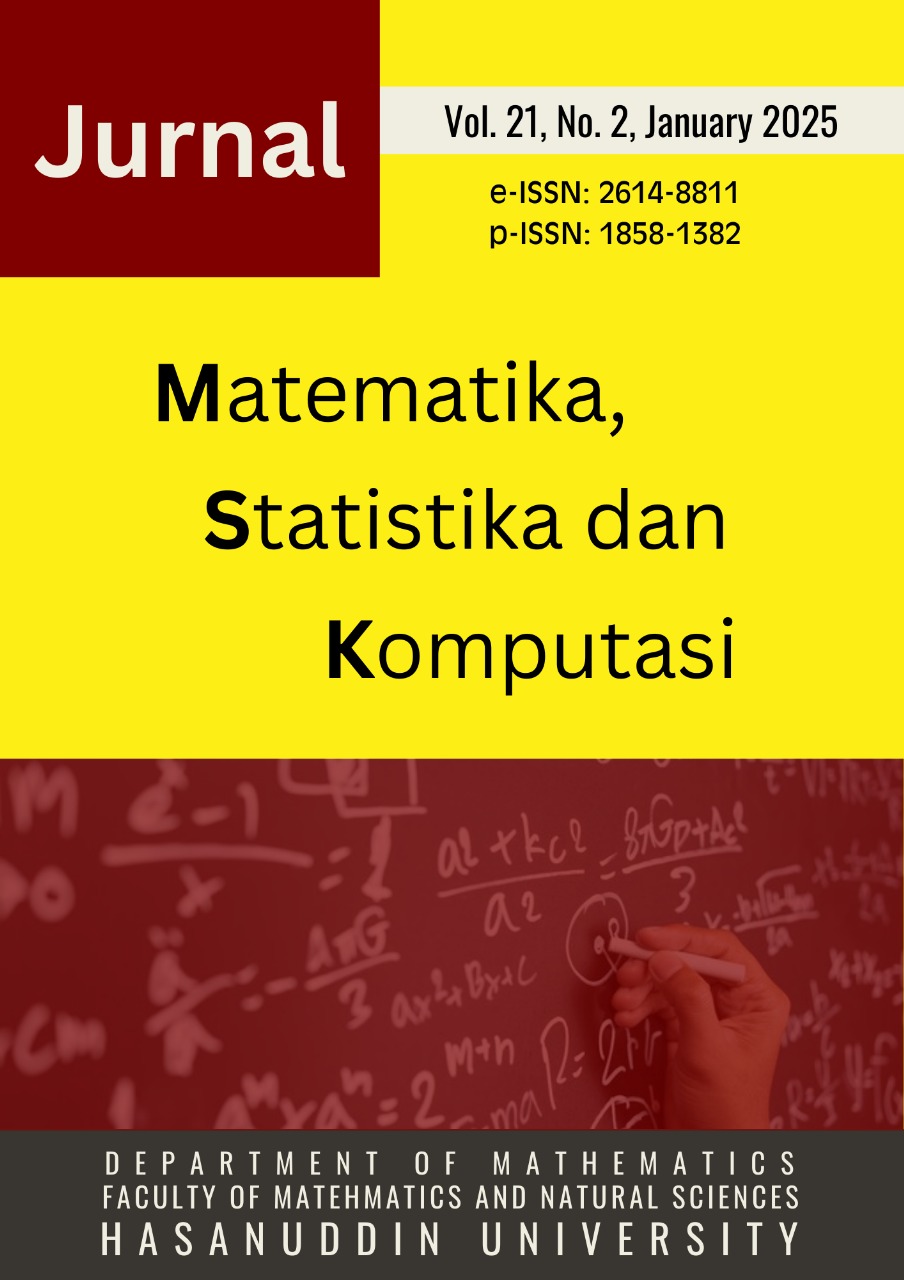Application of Autoregressive Integrated Moving Average (ARIMA) for Forecasting Inflation Rate in Indonesia
DOI:
https://doi.org/10.20956/j.v21i2.36609Keywords:
Inflation, Time Series Data, ARIMA, Economic StabilityAbstract
Inflation is one of the indicators to maintain economic stability. Controlling inflation reflects the success of economic growth, while very high or volatile inflation can lead to economic instability. The purpose of this research is to forecast the time series data of inflation rate in Indonesia until the end of 2024 using ARIMA method. The data used in this study are secondary data of monthly inflation rates in Indonesia from January 2003 to May 2024 obtained from the Bank Indonesia website. Based on the research results, the optimal model for forecasting the inflation rate in Indonesia until the end of 2024 is ARIMA (1,0,1) with a MAPE of 6.91%. The forecasting results show a stable and not too significant increase and are still within the target range set by Bank Indonesia and the Government, which is between 1,5% and 3,5% for 2024.
References
[1] Abdulrahman, B.M.A., Ahmed, A.Y.A. & Abdellah, A.E.Y., 2018. Forecasting of Sudan Inflation Rates using ARIMA Model. International Journal of Economics and Financial Issues, Vol. 8, No. 3, 17.
[2] Bhardwaj, S.P., Paul, R.K., Singh, D.R. & Singh, K.N., 2014. An Empirical Investigation of ARIMA and GARCH Models in Agricultural Price Forecasting. Economic Affairs, Vol. 59, No. 3, 415-428.
[3] Hidayati, N., 2024. Perbandingan Model Asymmetric Power ARCH dengan Threshold GARCH dalam Peramalan Kurs Poundsterling terhadap Kurs Rupiah. MATHunesa: Jurnal Ilmiah Matematika, Vol. 12, No. 1, 11-20.
[4] Huda, M., Azizah, R.N.N. & Setyana, A.N., 2023. Implementasi Metode ARMA dalam Peramalan Inflasi Provinsi Banten. Jurnal Bayesian: Jurnal Ilmiah Statistika dan Ekonometrika, Vol. 3, No. 2, 210-221.
[5] Hutasuhut, A.H., Anggraeni, W. & Tyasnurita, R., 2014. Pembuatan Aplikasi Pendukung Keputusan untuk Peramalan Persediaan Bahan Baku Produksi Plastik Blowing dan Inject Menggunakan Metode ARIMA (Autoregressive Integrated Moving Average) di CV. Asia. Jurnal Teknik ITS, Vol. 3, No. 2, A169-A174.
[6] Istiqomah, N., 2015. Prediksi Kemunculan Titik Panas di Provinsi Riau Menggunakan Seasonal Autoregressive Integrated Moving Average (SARIMA).
[7] Jagero, B.A., Mageto, T. & Mwalili, S., 2022. Modelling and Forecasting Inflation Rates in Kenya Using ARIMA Model. European Journal of Statistics and Probability, Vol. 11, No. 1, 54-68.
[8] Kennedy, P.S.J., 2018. Modul Ekonomi Makro Kompetensi Dasar: Mendeskripsikan Masalah-Masalah yang Dihadapi Pemerintah di Bidang Ekonomi.
[9] Laura, V., 2019. Peramalan Banyaknya Penabung di Credit Union Sumber Kasih Teraju dengan Metode Box-Jenkins. Universitas Sanata Dharma.
[10] Meiditambua, M.H., Centauri, S.A. & Fahlevi, M.R., 2023. Pengaruh Inflasi terhadap Pertumbuhan Ekonomi: Perspektif Indonesia. Jurnal Acitya Ardana, Vol. 3, No. 1, 17-26.
[11] Melani, V.D., Miftahuddin, M. & Subianto, M., 2022. Pemilihan Model ARFIMA-GPH dan Intervensi Multi Input pada Indeks Harga Perdagangan Besar Indonesia. Jurnal Gaussian, Vol. 11, No. 2, 163-172.
[12] Meyler, A., Kenny, G. & Quinn, T., 1998. Forecasting Irish Inflation Using ARIMA Models.
[13] Mukron, M.H., Susianti, I., Azzahra, F., Kumala, Y.N., Widiyana, F.R. & Al Haris, M., 2021. Peramalan Indeks Harga Konsumen Indonesia Menggunakan Autoregressive Integrated Moving Avarage. Jurnal Statistika Industri Dan Komputasi, Vol. 6, No. 1, 20-25.
[14] Okafor, C. & Shaibu, I., 2013. Application of ARIMA Models to Nigerian Inflation Dynamics. Research Journal of Finance and Accounting, Vol. 4, No. 3, 138-150.
[15] Purnama, J. & Juliana, A., 2020. Analisa Prediksi Indeks Harga Saham Gabungan Menggunakan Metode ARIMA. Cakrawala Management Business Journal, Vol. 2, No. 2, 454-468.
[16] Rifai, N.A.K. & Zhahirulhaq, M.A., 2024. Forecasting Inflation in Indonesia Using The Autoregressive Integrated Moving Average Method. Parameter: Journal of Statistics, Vol. 4, No. 1, 37-45.
[17] Safwandi, 2023. Time Series Model Using Autoregressive Integrated Moving Average (ARIMA) Method For Inflation In Indonesia. Vol. 8, 13-25.
[18] Sekine, T., 2001. Modeling and Forecasting Inflation in Japan.
[19] Setiawan, W., Juniati, E. & Farida, I., 2016. The Use of Triple Exponential Smoothing Method (Winter) in Forecasting Passenger of PT Kereta Api Indonesia with Optimization Alpha, Beta, and Gamma Parameters. In 2016 2nd International Conference on Science in Information Technology (ICSITech), 198-202. IEEE.
[20] Tchakondo, Y., 2022. Forecating Inflation in Togo Using an Autoregressive Model. Available at SSRN 4214913.
[21] Wahyuningtyas, A.R., Pratiwii, W.P., Wasono, R. & Utami, T.W., 2022. Peramalan Indeks Harga Konsumen Kabupaten Banyumas dengan Metode SARIMA. Jurnal Litbang Edusaintech, Vol. 3, No. 1, 56-60.
[22] William, W. & Wei, S., 2006. Time Series Analysis: Univariate and Multivariate Methods. Pearson Addison Wesley, USA, Segunda edicion, Cap. 10, 212-235.
Downloads
Published
How to Cite
Issue
Section
License
Copyright (c) 2025 Jurnal Matematika, Statistika dan Komputasi

This work is licensed under a Creative Commons Attribution 4.0 International License.

This work is licensed under a Creative Commons Attribution 4.0 International License.
Jurnal Matematika, Statistika dan Komputasi is an Open Access journal, all articles are distributed under the terms of the Creative Commons Attribution License, allowing third parties to copy and redistribute the material in any medium or format, transform, and build upon the material, provided the original work is properly cited and states its license. This license allows authors and readers to use all articles, data sets, graphics and appendices in data mining applications, search engines, web sites, blogs and other platforms by providing appropriate reference.







